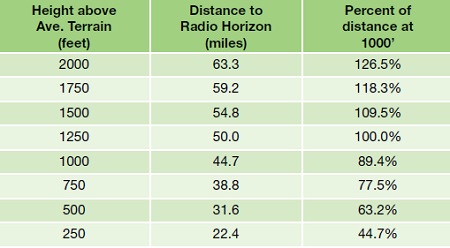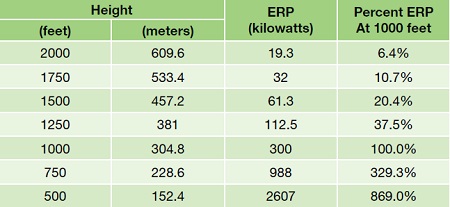One of the first questions to come up as broadcasters consider their options for auxiliary, interim and final DTV facilities is “How much will this impact my coverage?” The best way to determine this is to do an analysis of the scenarios using the FCC’s TVStudy software or another program to calculate coverage.
However, a quick analysis based on an understanding of how height above average terrain, effective radiated power (ERP) and coverage are related can be useful before doing a complete coverage estimate. I’ve run some calculations for common tower heights and power levels and created tables that illustrate the trade-offs.
DISTANCE TO RADIO HORIZON
Increasing tower height can be expensive whether building a tower or leasing space. In most cases interim or auxiliary antennas will be mounted below the main antenna. One element to consider is the distance to the radio horizon from the antenna. The radio horizon is further than the true horizon due to refraction in the atmosphere. The distance to the radio horizon is also useful in calculating coverage from a site for two-way radios or even line of sight microwave, assuming there is sufficient power to overcome the path loss over the distance.

Table 1: Distance to radio horizon
Table 1 shows the distance to the radio horizon for heights above average terrain (HAAT) from 250 feet to 2,000 feet. I also show the distance as a percent of the distance for a common 1,000 foot tower. The formula for calculating distance to the radio horizon where HAAT is in feet is:
Distance (miles) to radio horizon =1.415*SQRT(HAAT)
For HAAT between 1,000 and 2,000 feet, a rough rule of thumb is a 5-mile increase in distance for each 250-foot elevation change (1 mile per 50 feet). Outside this range, the thumb fails. Looking at the formula and the table, you can see that as height increases, the incremental improvement in distance per unit of height decreases.
The professional video industry's #1 source for news, trends and product and tech information. Sign up below.

Table 2: Distance to noise limited contour at channel 25 (39.85 dBμV/m). Effective radiated
FCC UHF COVERAGE CHANGES WITH HEIGHT
Coverage is possible beyond the radio horizon, but without line of sight, more power is required and the amount of power varies with frequency band. I’ve shown how the distance to the radio horizon changes with HAAT, now let’s look at the impact on FCC coverage.
Table 2 shows coverage to the FCC service contour (39.85 dBμV/m) from a site with 300 kW ERP on channel 25. Notice that for the same height the FCC coverage goes substantially beyond the radio horizon distances in Table 1. The rule of thumb change for HAAT between 1,000 and 2,000 feet is a bit less, about 4 miles per 250 feet height change.

Table 3: ERP required to match coverage from 300 kW at 1000 feet above average terrain
CAN POWER OFFSET HEIGHT REDUCTION?
The final analysis looks at the change in ERP required to maintain FCC coverage at a fixed distance as height changes. Table 3 shows the results obtained with TVStudy’s “ptelev” utility for changes in height to a baseline facility with 300 kW ERP at an HAAT of 1,000 feet to maintain the FCC service area contour at 55.2 miles. To avoid extending the contour if the antenna is raised 250 feet, the ERP has to drop to 112.5 kW.
Why the big difference? Look at Table 1; this increase moves the radio horizon closer to the contour. At 1,500 feet the radio horizon almost matches the FCC contour distance at 1,000 feet and the required ERP drops to only 61.3 kW from 300 kW!
Broadcasters looking to move their replication antenna from a sidemount location to a topmount spot occupied by their old analog antenna have noticed a reduction in ERP. As these calculations are based on HAAT (height above average terrain), the difference would not have been nearly as great for stations on mountaintops as for “flatland” stations with tall towers.
What if the antenna has to go lower in height? Can a power increase offset the height reduction? Table 3 shows that for a reduction in HAAT from 1,000 feet to 750 feet, ERP has to be almost tripled to match the contour from the higher site. Going from 1,500 feet to 1,250 feet would require less than double the power. For a very tall tower, going from 2,000 feet to 1,750 feet requires a bit more than 50 percent power in the example we used.
Because of the impact of HAAT on the radio horizon, the required differences will change depending on the baseline ERP, HAAT and resulting coverage contour. I used the “ptelev” command line utility included with TVStudy to generate these tables. It can also calculate HAAT for non-flatland sites. A simpler method if TVStudy is not available, is the FCC Javascript application for calculating field strength at a given distance for a given HAAT and power (ERP) or distance to a given field strength for a given HAAT and power. It is available at https://www.fcc.gov/media/radio/fm-and-tv-propagation-curves.
REPACK REVIEW
Like many other broadcast engineers, I have been involved with the FCC 399 forms for reimbursement. Overall, I’ve been impressed with the job the reviewers are doing. For complicated questions, the review gets assigned to an experienced consulting engineer contracted by the FCC. They know how broadcasting works. While this helps them root out people asking for more than the FCC allows, I’ve also found they’ll remind broadcasters to doublecheck if they see they may have missed listing an item or cost that’s obviously needed. They are really interested in getting as accurate, complete, estimate of expenses as possible.
Broadcasters submitting forms and updates can help the reviewers. I’ve been told one of the most frustrating parts of the job is being presented with a Form 399 with loads of attachments with quotes and estimates and nothing tying the quotes and estimates back to the numbers in the Form 399. There may even be multiple quotes for the same thing, installation included in the transmitter quote and a separate quote for transmitter installation, for example.
To make things easier for the FCC, attach a spreadsheet that lists the item number in the Form 399, the file name of the quote the item is coming from, the line number or other description of where the item is in the quote, and the value in the quote to be used. This should match the Form 399 value; if not, include some explanation why—state sales tax could be one example. While we hope the review process will be complete by the time you read this, the 399’s will have to be updated as real quotes come in and final invoices are received.
If you wonder what other stations filed for in their Form 399, the forms are available in LMS. Use the Application Search atand enter the call letters of the station you are interested in. All applications will be listed, but the Form 399’s should be near the top. Click on the column heading on the page to sort results by that column.
Next month I’ll cover topics from the IEEE Broadcast Symposium taking place in Washington, D.C. this month. I welcome your comments and questions, email me atdlung@transmitter.com.

Doug Lung is one of America's foremost authorities on broadcast RF technology. As vice president of Broadcast Technology for NBCUniversal Local, H. Douglas Lung leads NBC and Telemundo-owned stations’ RF and transmission affairs, including microwave, radars, satellite uplinks, and FCC technical filings. Beginning his career in 1976 at KSCI in Los Angeles, Lung has nearly 50 years of experience in broadcast television engineering. Beginning in 1985, he led the engineering department for what was to become the Telemundo network and station group, assisting in the design, construction and installation of the company’s broadcast and cable facilities. Other projects include work on the launch of Hawaii’s first UHF TV station, the rollout and testing of the ATSC mobile-handheld standard, and software development related to the incentive auction TV spectrum repack. A longtime columnist for TV Technology, Doug is also a regular contributor to IEEE Broadcast Technology. He is the recipient of the 2023 NAB Television Engineering Award. He also received a Tech Leadership Award from TV Tech publisher Future plc in 2021 and is a member of the IEEE Broadcast Technology Society and the Society of Broadcast Engineers.
